Trish Manfredi, Domestic Cow Antiques & Events
photos by Peter Blieberg and Trish Manfredi

The vintage milk bottle is, for beginner and seasoned collectors, one of the most fascinating to be encountered. Although they are somewhat easily found at antique shops, barn, and tag sales, at antique bottle shows, and sometimes in unusual places (like the time I found lots of them on the ground with grass growing over them at a barn sale), the history and science behind them make them more interesting as a collector dives deeper into the development of this staple container. The range of vintage milk bottles is extensive, so there’s likely to be a category to interest you.
First, the Cows
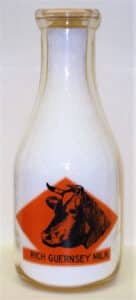
Cows came to America first around 1611 at the Jamestown Colony, by 1624 to the Plymouth Colony, and around 1638-39, Mitchell of Saybrook, Connecticut came up the Connecticut River to Glastonbury, CT in search of grazing lands.
By 1821, Goshen, Connecticut was praised as having the best land in the state, resulting in 400,000 pounds of cheese being produced annually, along with great quantities of butter and other dairy products in general.
In 1852, a Massachusetts farmer named Winthrop Chenery brought Holstein cattle from Holland to meet the growing demands for dairy products in this expanding country, and Jersey cows were being brought to the U.S. from England. As other breeds became known, they were brought to the U.S. where grazing was abundant.
Then, the Glass
Housewives would go to dairies to collect milk in their own containers often made of tin and made at home. As the production of containers to deliver food across broader areas met the Industrial Revolution—likely influenced by the expanding fruit (canning) jar industry—glass bottles designed to hold liquid milk became the way to go.

Soon, several milk bottles of varying sizes and closures appeared on the scene. The first was the Lester Jar, around 1874, followed by the Thatcher Milk bottle in 1884. In the late 1800s, several other early jars were invented – the Crystal jar, the Common-Sense bottle, etc. alongside the development of improved milking machines and inventive ways to take care of the cows. Various types of bottle closures—glass lids, wire bails, tin tops, and cardboard caps—were developed for milk bottles.

Early glass milk bottles were thick and heavy. The Thatcher bottle had a picture of a man milking a cow, embossed on the side of the bottle. As dairies invested in bottles, the name of the dairy was often embossed on the bottle, along with the town name and the state. Creative graphics that expressed the dairy’s name, such as a maple tree, were also embossed on bottles.
Turning to Paper
Glass milk bottles were popular from the 1920s to the early 1950s. In 1948, plastic-coated paper milk cartons were introduced commercially, and by 1952, 40% of US milk was sold in wax-coated paper cartons rather than glass bottles. The plastic milk container was introduced in 1964.
By 1967, 70% of US milk was sold in paper cartons, and the glass milk bottle was fading from the scene, as was home delivery, down to just 25% of households from the high of 50% prior to WWII.
And, the Collection

Today, vintage glass milk bottles are collectible, with a wide range of unique categories to tempt collectors. There are two main types of milk bottles: embossed – that is with raised lettering and graphics on the surface of the bottle; and pyro-glazed – heat-set paint lettering and graphics, also called an applied color label (ACL). Collectors often specialize in one or the other, depending on other desired qualities they are searching for such as names of particular dairy farms, and may look for both.
A popular collecting category is the family bottle from dairies that were in the family or worked at by family members. Often, bottles from a family dairy were sold or destroyed when the dairy closed, yet current generations often look for and want a tangible memento.
Another popular category is to collect bottles from all the towns in a county, or from one town or one state. For the more ambitious collector, there’s the goal of a 50-state collection – one bottle from each state, preferably with the name of the state spelled out!
Some collectors focus on one size of a milk bottle, as bottles were made in a range of sizes for different uses. Quarts are among the most popular, although pints, half-pints, half gallons, and gallon bottles have their aficionados. Milk bottles are found in two main shapes: round and square.
The early bottles were round, and as refrigerators became more common, square bottles became more popular as they took less space in the refrigerator.
Another very collectible category is the institutional bottle. Hospitals, colleges and universities, schools (such as agricultural schools and other schools offering lunch programs), and prisons often had dairies producing and bottling their own milk.
Other Things to Look For in a Vintage Milk Bottle
The Slogan
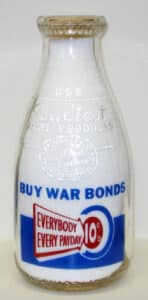
A special collectible milk bottle in time is one that included a war slogan. Milk bottles with the phrase “Buy War Bonds” or “Support Our Troops,” often with pictures of flags, ships, airplanes, and soldiers.
Other popular milk bottle motifs include barns, babies, and food items such as ice cream. Graphics on bottles were an opportunity for marketing related dairy products.
Milk bottles with Disney characters are extremely sought after, and a related category is milk bottles with nursery rhymes printed on them. Borden’s Elsie the Cow was a popular character on milk bottles.
The Color
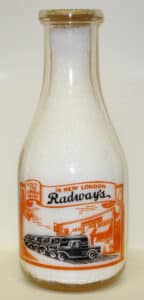
Some collectors seek out milk bottles with a specific color of pyro glazing – red, green, blue, etc. Others try to acquire bottles with two colors of pyro or the even rarer – three colors. The Wauregan Dairy, Wauregan, CT, varied the colors on their bottles: red, red, and black, and just black pyro glazing, some of which may have been errors!
The Return
Another collectible category is the deposit bottle. Because of the cost of bottles with the dairy’s name on them, the dairy wanted the bottles returned to be re-used. To encourage this, a deposit was included in the price, just as today we pay a deposit for soda bottles. The deposit levels ranged from one cent to ten cents or more, with five cents being the most common.
The Breeds
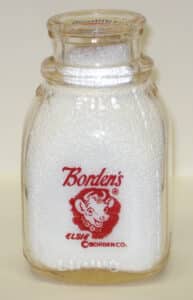
There are collectors seeking their favorite milking cow breed featured on the bottle. While Elsie the Cow was the mascot for Borden Milk since 1936, there was some controversy regarding which breed she represented. The first living Elsie was a registered Jersey Heifer from Elm Hill Farm in Brookfield, Massachusetts. While the Jersey breed was popular, keep an eye out for Guernsey, Ayrshire, Brown Swiss, and Holstein, too.
The Cream at the Top
The shape of the bottle also offers collectors a range of options. These are variations on the typical round or square bottles. For example, before homogenized milk was available, the cream in milk would rise to the top of the bottle, so to promote the amount of cream, the cream top milk bottle was created. The top of the bottle is a bowl shape that contains the cream.

variation—the long neck—showing the cream top spoon, and what to do
with the cream.
For other glass companies to make a cream top bottle without infringing on the original patent, the babyface cream top was designed where a baby’s face is embossed onto the bowl, while others embossed the face of a policeman plus a collar. Yet another design to serve the same purpose was the toothache bottle with a bulge on the side near the top rather than the bowl. The name came from the fact that the bulge looked like a jaw swollen when a tooth ached. The cream line bottle took another approach, with several embossed rings at different levels to delineate the amount of cream in the milk!
The Graphics of the Vintage Milk Bottle
Some dairies created different graphics over the life of the dairy. Cloverleaf Dairy from Salt Lake City, Utah, had a series of bottles with different recipes using milk printed on their bottles. Some designs are unique – a square quart bottle from Gulf Hill Farms, South Dartmouth, Massachusetts in 1959, is orange pyro on one side with two cow heads and the dairy name, and on the other side shows a whale and “Try our delicious Moby Dick Quahaug Chowder” in green.
Quite often, there are initials on the base of the bottle to indicate the manufacturer of the bottle. “mTc” was Thatcher Manufacturing Company, and the date the bottle was made.
Other Dairy Collectibles
Just for Cream
Related to milk bottle collecting, are creamers, the small glass bottles that were often used in diners, like the small plastic containers used today. Creamers often had the name of the dairy on them, although due to the small size, many didn’t have the city and state on them. Other related categories are sour cream jars and condensed milk jars. A sub-category is a bottle from a goat dairy – yes, goat milk was (and still is) bottled and sold.
The Closer
The way a milk bottle is closed also offers collecting options. One of the earlier forms is the Thatcher, which had a glass dome, with a bail wire. A tin-top was used on early bottles, particularly the Smalley, which came with a metal handle. Serious collectors try to obtain the cardboard milk cap with the name of the dairy that matches the name on the bottle.
Caps were a way to keep debris from entering the bottle. There are also ‘generic’ caps with promotional information. Printing on the cap was much less expensive than embossing or pyro glazing the bottle.
Caps were also used to designate the day of the week that the milk was bottled – “day of the week” caps are highly sought after. Most authentic milk bottles have a “cap seat” – a recessed edge just below the top of the bottle, which held the cap securely to keep the milk from leaking. Special metal tools, called “cap picks” were used to pry the cap from the bottle. The picks often have the name of the dairy on them.
The Go-With
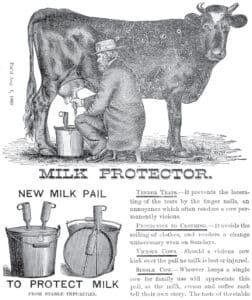
Dairy-related items, known to milk bottle collectors as “go-withs” are very popular. These include calendars, some all paper, and others with a photo or artwork under glass and in a frame, from which the calendar hung. With the name of the dairy on the calendar, these were given to customers to celebrate the New Year.
Milk bottle carriers are made of heavy wire or flat metal to hold 4 to 6 or more bottles, sometimes with the dairy’s name on the handle. These were used by the milkman to deliver bottles to the home. A related collectible is the “porch box,” a wood or metal box, often with the dairy name on it, in which the milkman would place the day’s order of milk.
The cream top spoon, a small ladle-like utensil, was paired with the various cream top bottles to make it easy for the housewife to remove the cream. There are generic spoons and a few with dairy names on the handle.
The Glass of Vintage Milk Bottles
The majority of milk bottles are clear glass with very early bottles rather thick; as manufacturing improved, bottles became thinner, meaning less weight for milkmen to carry.
There are a few authentic bottles in colored glass. Amber-colored bottles were thought to protect the milk from light. A few dairies tried a light green glass. A small run of red bottles was produced for Borden, resulting in the “Ruby Red” milk bottle, highly desired by serious collectors.
The Fakes
As with so many collectibles, reproductions are out there. If a milk bottle is pink or blue, it’s a reproduction! If it is a lightweight bottle, without a cap seat, it’s likely to be a “repro.” A pint “Heritage’ bottle is available by the case, directly from China – clearly a reproduction.
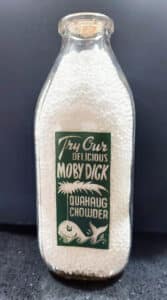
Serious collectors display their bottles in cabinets and on shelves. To make the pyro glazing stand out, very small, white styrofoam beads are used as a lightweight filler, to look like milk. For creamers, white cotton balls are often used. Coating the inside of bottles with paint or filling them with sugar is not recommended!
Want to Learn More About Milk Bottles?
Join the National Association of Milk Bottle Collectors (NAMBC), which celebrated its 40th anniversary in 2020. Its monthly newsletter, The Milk Route, showcases dairies and bottles. NAMBC will hold its annual convention in Sturbridge, Massachusetts May 20-21, 2022. Seminars, an auction, and sales in rooms along with meeting collectors from all over the country make for a fun two days.
For details on joining NAMBC and attending the convention, visit www.milkbottlecollectors.com. NAMBC also has a Facebook page – www.facebook.com/groups/nambcmembers – just search Facebook for NAMBC.
Another way to learn about milk bottles is to join an Antique Bottle Club and/or attend an antique bottle show – the Federation of Historical Bottle Collectors (FOHBC) www.fohbc.org has a detailed calendar of shows around the country. For a detailed history and information on milk bottles, books by John Tutton are invaluable – the first book Udder Delight contains comprehensive information on the early bottles, including patent information. Subsequent books feature pyro glazed bottles – there are a total of five books that are available from online sellers.
Trish Manfredi, along with her husband Peter, own Domestic Cow Antiques and Events, specializing in vintage Connecticut and other milk bottles and kitchenware. Both serve on the Board of Directors for NAMBC. Trish has collected deposit bottles, and bottles with eggs and chickens on them, along with caps that have kitchen utensils on them.

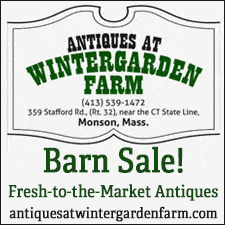


Related posts: